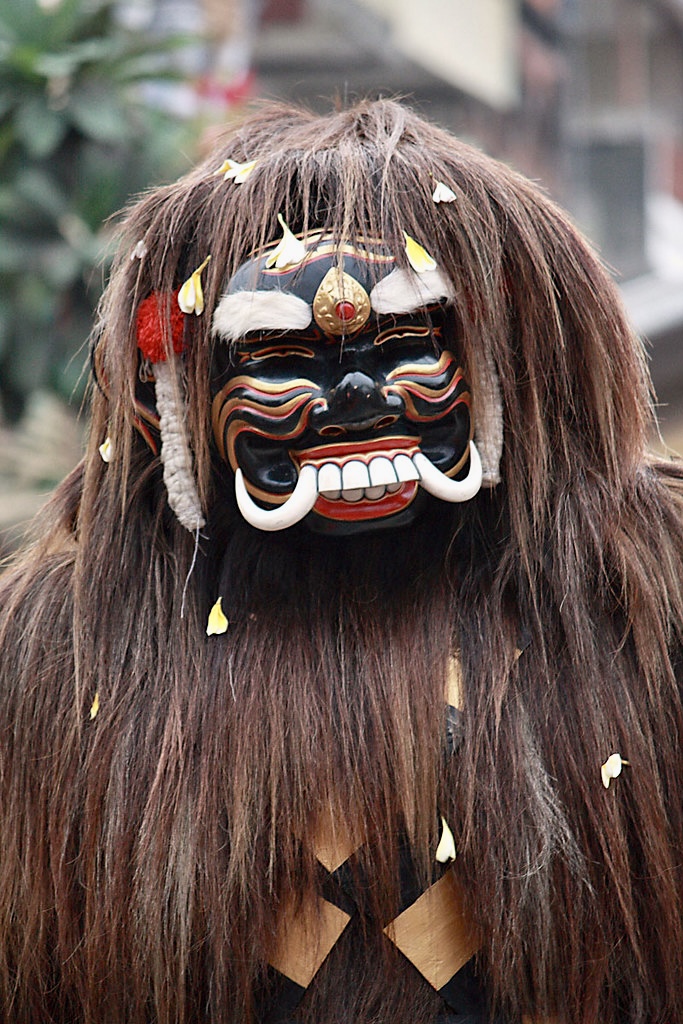Macaling, The Most Horrific Of Bali Demons-And There Are A Lot To Choose From
Origins of Nyepi — The Day of Silence
Thursday, March 3, 2022 was the beautiful, contemplative experience of Nyepi. This event marks the Bali New Year and is the most sacred holiday in Bali. The day prior to Nyepi, there is a cleansing ceremony on the beach; and later, everyone was out on the streets celebrating the parade of the Ogoh Ogoh. Nyepi itself is a quiet twenty four hours where a person could ponder life, families can perform ceremonies, or people give words of thanks to the Gods. Thus, Nyepi is a religous day of meditation, prayer, cleansing while spending the day with household members. During Nyepi, shops are closed, streets are empty and even the Bali International Airport is shut down. Television and phone services are all unplugged. At home, there is no music blaring nor use of anything electric, except minimal lights are allowed. But the Day of Silence is not only a day of meditation. The emphasis on quietude and home stay has a second purpose: avoiding the hideous Demon Jero Gede Macaling. The Demon is allowed this one day to leave his protective lair to prowl the streets. Macaling is looking for victims to take and kill; or drag back to Hell with him. Thus, the Balinese are quiet so as to not draw Macauling attention as he passes by.
March, 2022. By Made Victor (Bali name of writer Zephyr Carlyle) Bali New Year Day is not just a day of revelry or retrospect. Nyepi is a day of quiet home enjoyment with a little fear mixed in. Macaling, this awesome — [Note: awesome means spectacular but fear inducing]— this awesome, horrific monster has the full honorific name of “the Honourable Fanged One,” or “Jero Gede Mecaling.” And do not believe this is fairy tale to scare kids. Ask the Balinese. Especially ask those who live along the southern coast of Bali facing the the nearby island of Nusa Penida. A long time ago Macaling was banished from Bali and fled to Nusa Penida, also called Black Magic Island. Macauling does sneak ashore from time to time but always surreptitiously. The preferred times for him to leave Nusa Penida is sunrise, noon or dusk. Stealthily, he lands on the Bali shore opposite from his island refuge. He always lurks around the coastlne. Macaling’s meandering path of murder is just one of the reasons that locals are dumfounded by the foreigners. Why are the bules (foreign ex-pats) willing to pay a pretty penny to buy Bali beach-front property that faces Nusa Penida? Bules are snapping up lands that are the stomping grounds of the evil Macaling.
The locals speak from experience: Some southern Balinese have seen Macaling with their own eyes; while others have felt the bite of his fangs. To ward off this lurking evil, Balinese close to Nusa Penida undertake small ceremonial rituals daily to prevent anyone from falling under his sway. Children are especially at risk. However, one day a year, on Nyepi, Macaling is allowed to return to Bali and runs amok. He becomes terrifying, and will claim his dues from any victim he can find. His thirst for blood is unquenchable. However, if you remain safely at home inside your house, Macaling can not find you or claim you as a victim. You are safe as long as you stay home and do not do anything that would draw the attention of Macaling.
Jero Gede Macaling …. in the flesh
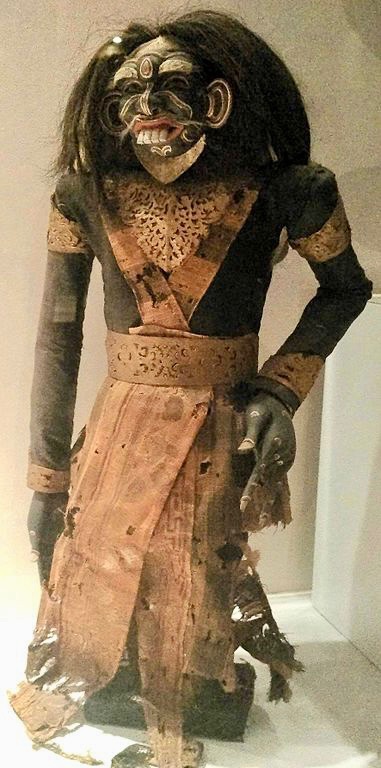
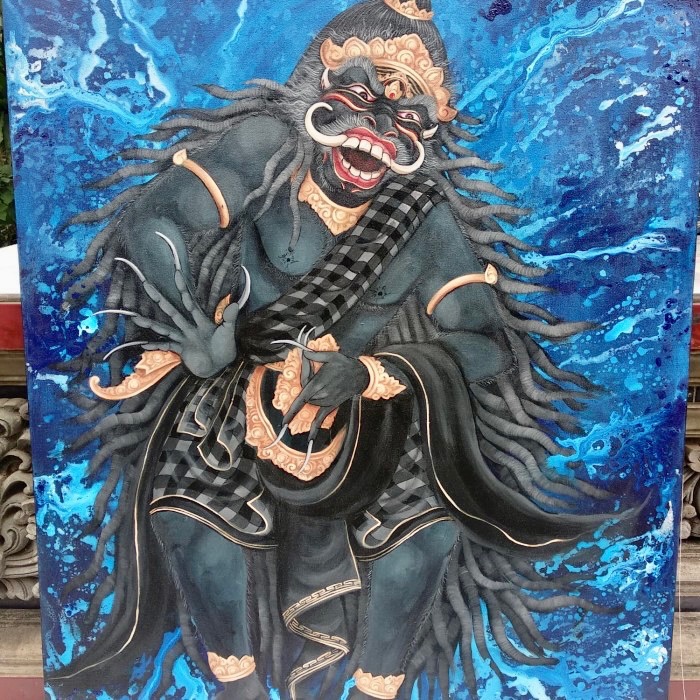
Nyepi did not start out as a day of hibernation and medition. Nyepi originally was simply Bali’s New Years Day: a day of celebration. However, on one fateful day when the people were celebrating Nyepi, Macaling could hear them from his exile in nearby Nusa Penida. Macaling was angered with all the happiness and joy coming from the Balinese. He decided to make them suffer. Macaling slipped away from Nusa Penida. He went to Bali in the disguise of the wisest and most respected god in Bali. Macaling took with him his army of demons. Macaling and the other demons destroyed everything. Yet, Macaling and his demon horde are still allowed to return every Nyepi to seek vengeance. In response, the Balinese decided to remain at home on Nyepi so Macaling can not catch them. Ever since the famous Macaling raid, the Balinese New Year is a Day of Silence. Nobody makes noise or has fun; so as not to catch the attention of Macaling, who will inflict untold misery on the noisemakers.
Enter the Ogoh Ogohs – The Demons Who Usher in Nyepi
The Ogoh-Ogohs (I did not make-up this name) are fantastic beings, mostly demons. According to the anthropolgy stuff I read, Ogoh Ogohs “reflect the spiritual aims of Hindu philosophy but are a unique synthesis of Hinduism and traditional Bali religion.” The Ogoh Ogohs take many different forms and shapes. The night before Nyepi, statues of the Ogoh Ogohs parade down the main street of every village and town in Bali. The streets are lined with celebratory observers. Below is a staid, rather plain, Ogoh Ogoh –seriously, this blue Ogoh Ogoh is normal-looking, when compared to other, really wild Ogoh Ogohs. This three headed, blue demon is found in the bule trendy town of Ubud:
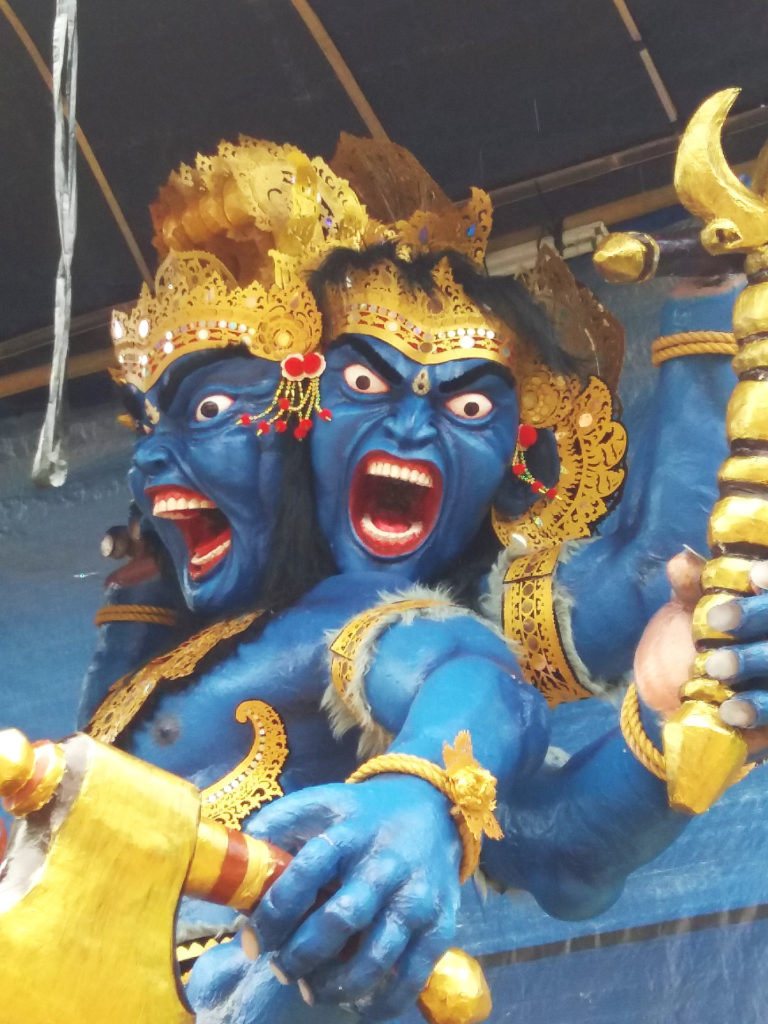
The Ogoh Ogoh above is rooted in reality when compared to many of the surreal, hallucinogenic Ogoh Ogohs out there. Think I am kidding? Try these on for size:

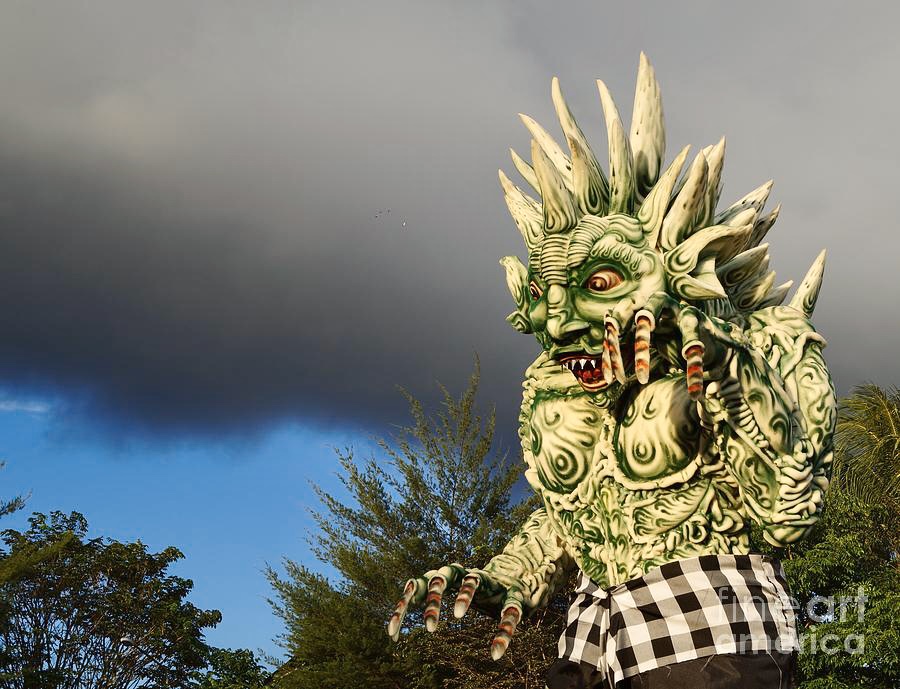
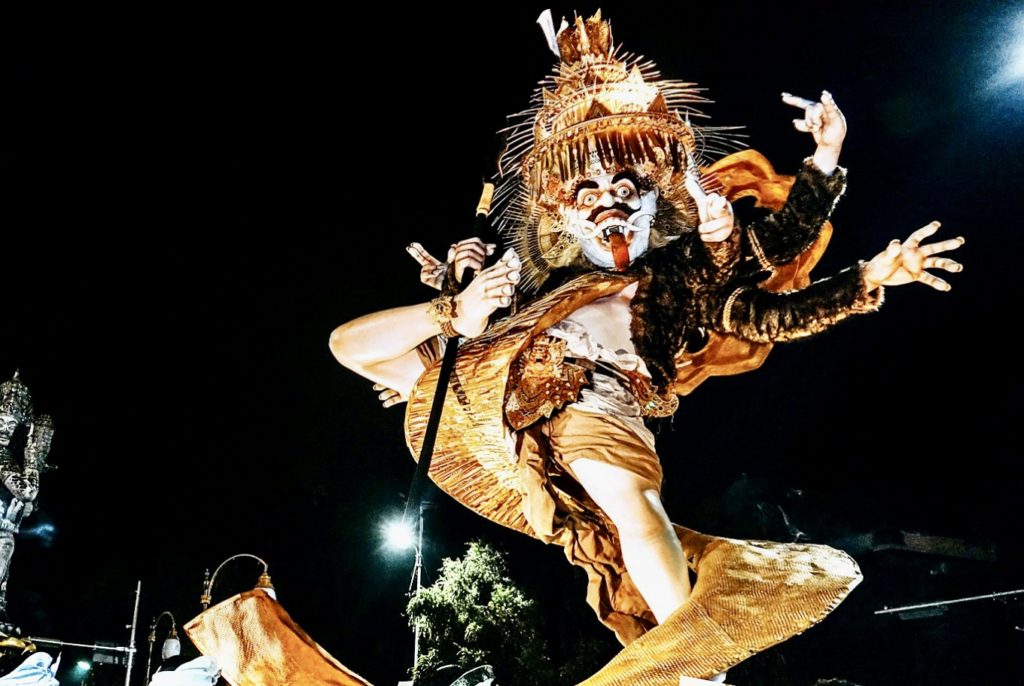
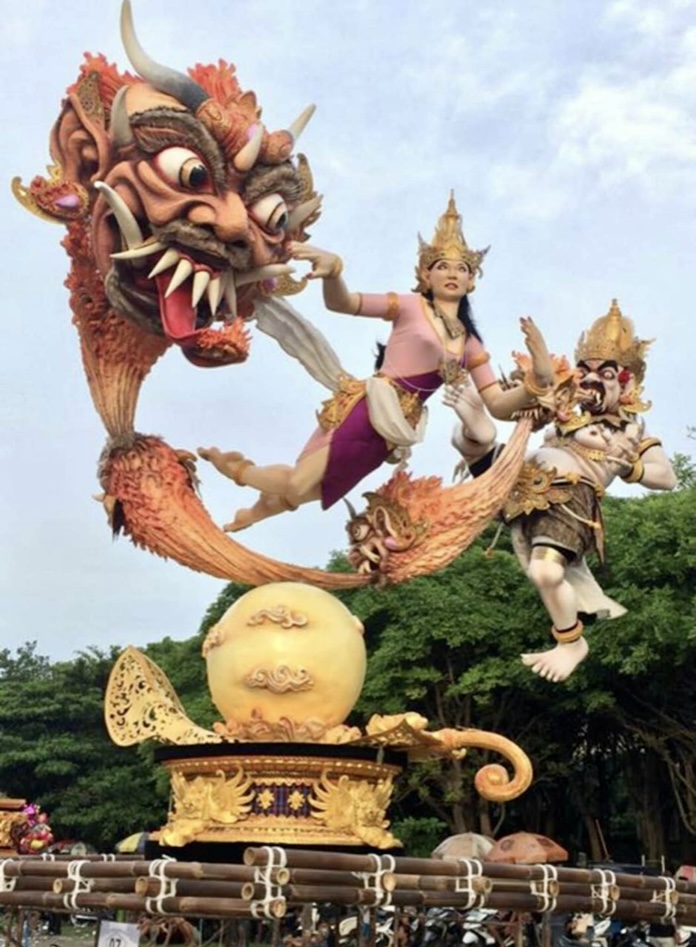

Each village usually build one Ogoh-Ogoh. There seems to be an endless number of Ogoh Ogohs to choose from. First, the Ogoh Ogoh is paraded around town on a huge bamboo pallet drawn by eight local muscle men. Then, the Ogoh Ogoh is carted off to a cemetery, where it is burnt to ashes as a symbol of self-purification.

Above:the Ogoh Ogoh who paraded down the main street of my neighborhood village in Canggu. This statue had a light show. He was bath in four different colored, rotating lights. Right: the same Ogoh Ogoh in green.


How I Spent My Nyepi
I had a relaxing Nyepi at home, just like everyone else, except those looking over their shoulder for Macaling. I live in a gated villa: the standard-issue housing for bules. Villas start at a level of Western middle–class luxury, and move on up to truly extravagant. One of the hallmarks of a villa is a spacious outdoor kitchens in open air pavilions. The more upper-class villas have indoor kitchens. I have a “shared villa” meaning there are two other units in the complex. All three villas share the mandatory villa facilities: swimming pool; common outdoor kitchen; seating areas; and gardens, big or small. Villas are enclosed behind a perimeter wall with a solid, wooden entrance door; all of which provides privacy from nosey passers-by and thieves. Villas are a blend of upscale Western housing (the obligatory swimming pool is not Bali) combined with Indonesian design touches. There are an endless number of villas in Bali; as many villas as bules, or so it seems. The urban areas of Bali have so many villas that the island critics bemoan the ”villifaction of Bali.”
In additon to taking a gander at my home, this section will have a New York commentary — this is also known as telling readers all the prices. Below is the exterior area of my villa. All exterior pictures were taken during a pouring rain as Bali is inching towards the end of the rainy season – look at the pool for confirmation. The villa complex has the three units in an “L” shape formation; all facing the swimming pool. My villa is in the short end of the “L.” I rent the largest villa and have more privacy. However, my villa does not open up to look directly at the garden wall across the pool, like the other two units. Cost: All inclusive rent is $500 a month for this furnished villa – including maid service, and free bottled water and most importantly, AIR CONDITIONING. I did buy a few accessory furnishings.
Side note: On any given day in the rainy season, we could have a spectrum of rain events. This could be from light rain like kisses to monsoon-like conditions in which it rains rope. However, the rain normally clears out in two to three hours; sometimes returning later that day. Sometimes there is no rain at all for a stretch of several days or even a week. The rainy season is not a crisis, but it is a hassle for the many, many motorbike drivers. The rainy season makes for an iffy proposition for those planning for a completely sunny clime on a day-trip. Bring an umbrella. The rainy season runs from December to February. Expanding the pictures below gives a much better sense of villa life.
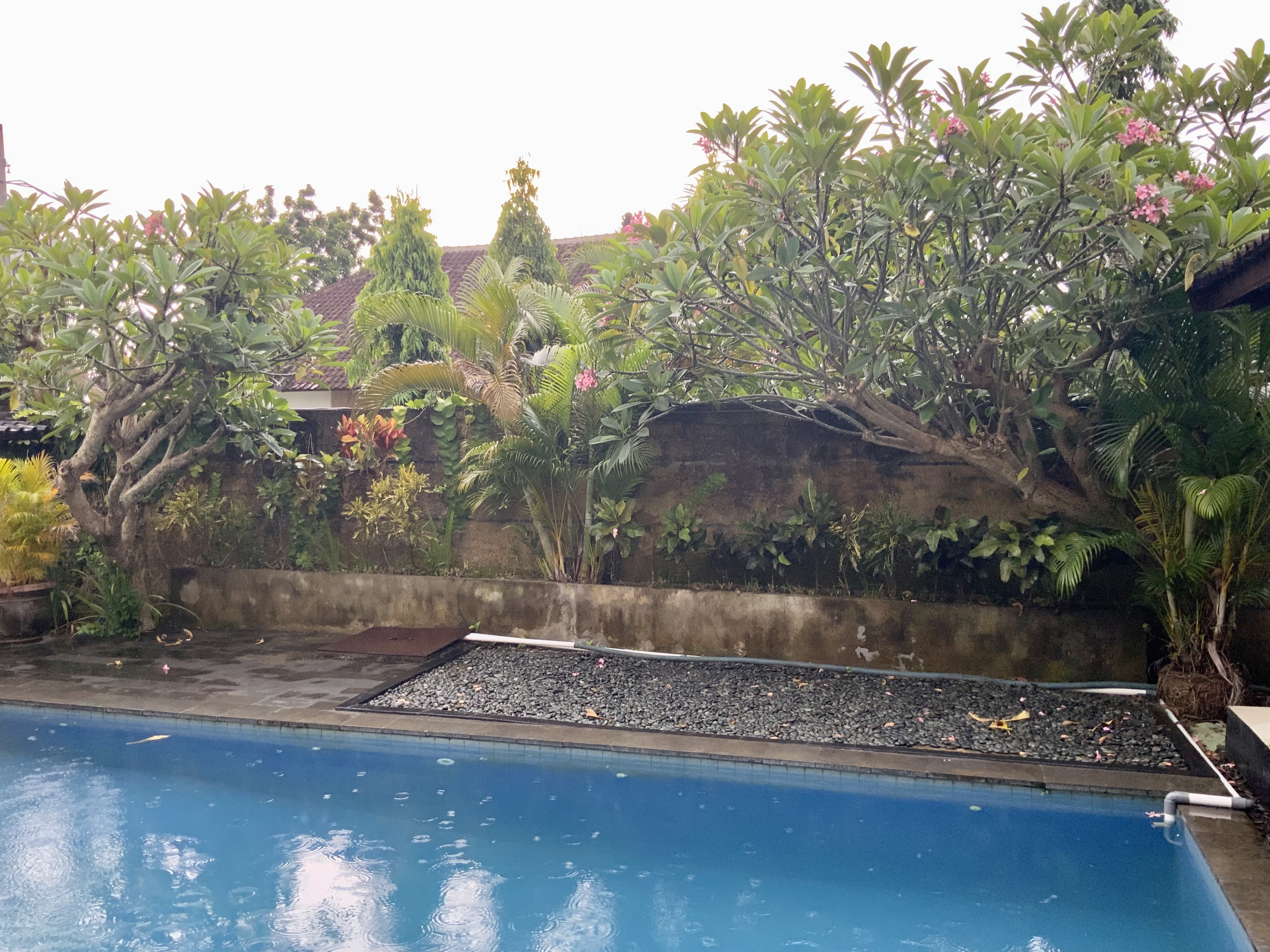


Below is the interior of my villa. I have a very large room by my standards as a budget traveler. Plus, there is a much smaller secondary area with an armoire and storage space. This small antechamber leads to the adjacent large bathroom with both shower and bathtub. I converted the smaller area to a functioning office. I put curtains in the archway that separates the bedroom from the office. I now have a small apartment. Expand these photos to get a better sense of my Macaling hiding lair, also known as the place where I hang my hat.
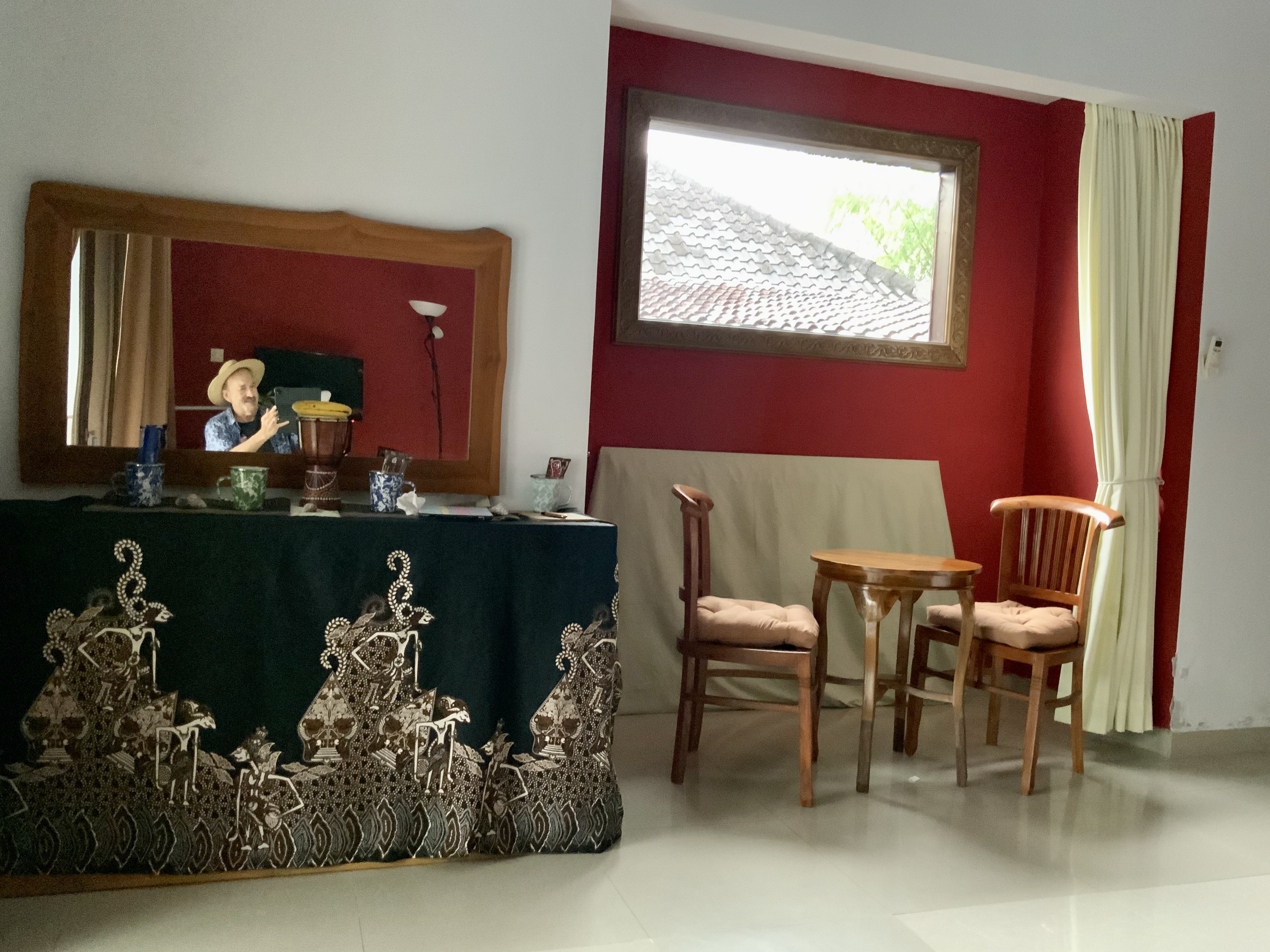
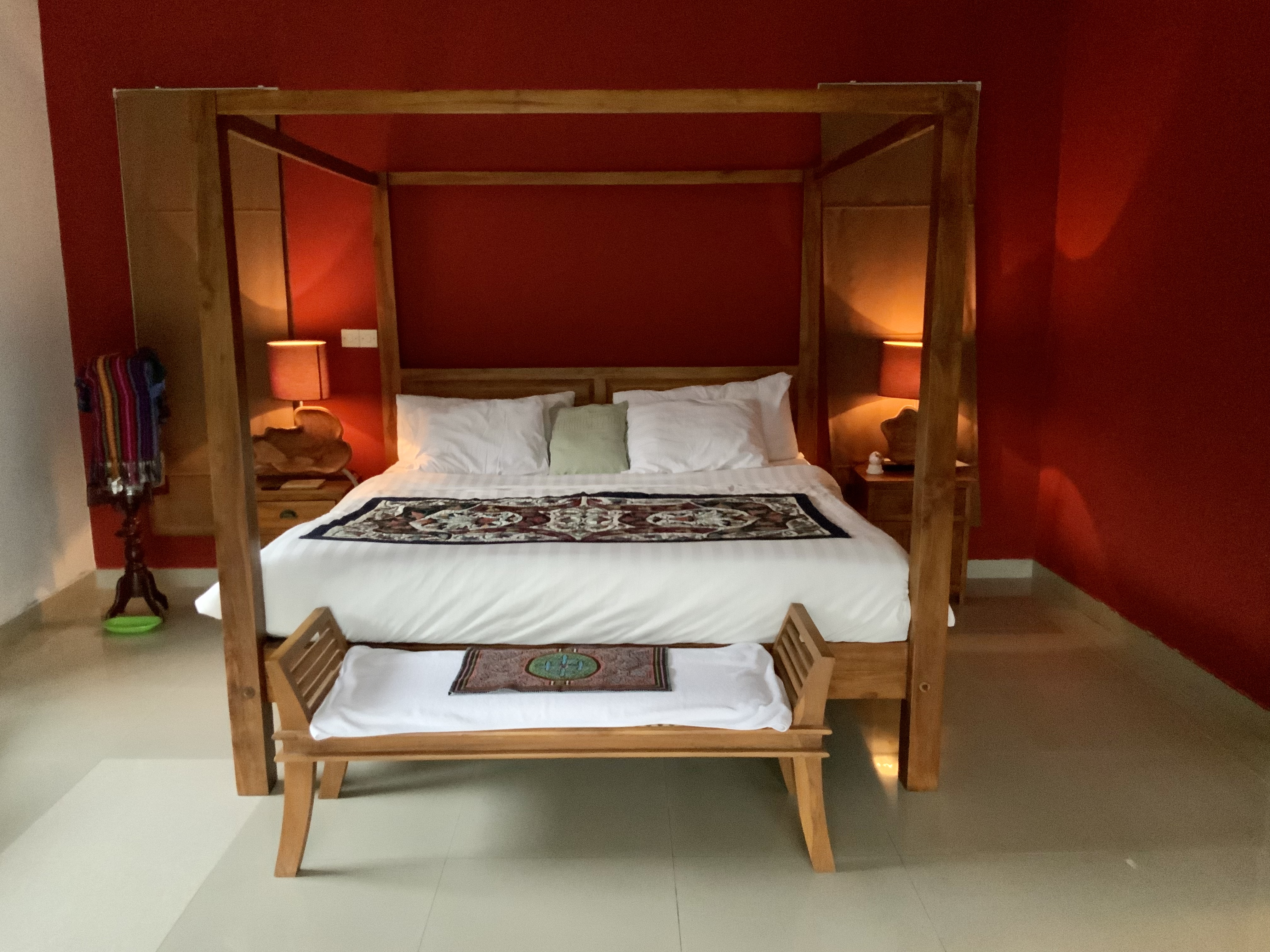

Cost breakdown of bedroom items in upper left picture. The table and two chairs were made in Canggu from beautiful Indonesian hardwood. Indonesia is famous for wood craft. The center for making wood furniture is in the city of Jepara, in Java. The bistro table was originally too low for dining or computer work. I had the wood worker extend the legs 5”. He carved into the bottom of existing legs and made a corresponding design on the extensions. He then joined the leg and extension using tongue and groove. I would have sawed off pieces of 5” wood and used superglue to pop them onto the bottom of the original legs. Cost: Table and two chairs. Total – $67. Additional Cost: Four table leg extensions. Total – $7.75. Cost: Cushions – $4 apiece. Cost: Java sarong – $9.
A New Tradition Arises: Balinese Motorbike Culture
On the way to the Ogoh Ogoh parade, this is what I espied on the road. The pictures speak for themselves.
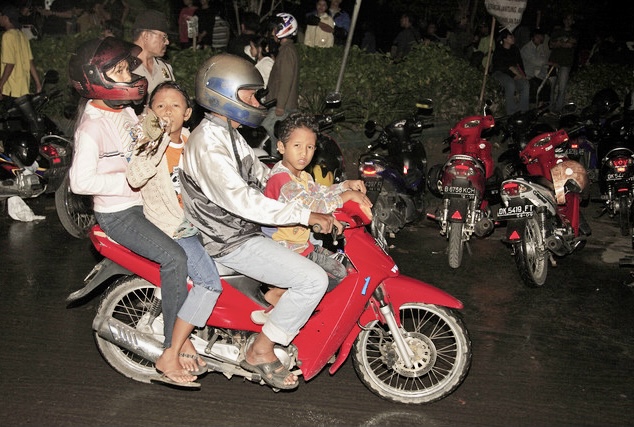
Above: These four folks do not even hold the record. I have seen a family of five on one motorbike. Compare below: A motorbike with four dogs. Again, I have seen up five or six dogs on one motorbike. The flying photographer of this picture — the guy with the beard — is Amit Gupta. Amit owns and operates the best little Indian restaurant in the Canggu area — Bali’s Corner. This nifty little restaurant is just down the street where I live on Jalan Nelayan. This road name translates to Fisherman Street. Jalan Nelayan is right off the main drag of Jalan Batu Bolong, (Rock with a Hole in the Center Street), the downtown area of this Canggu section.
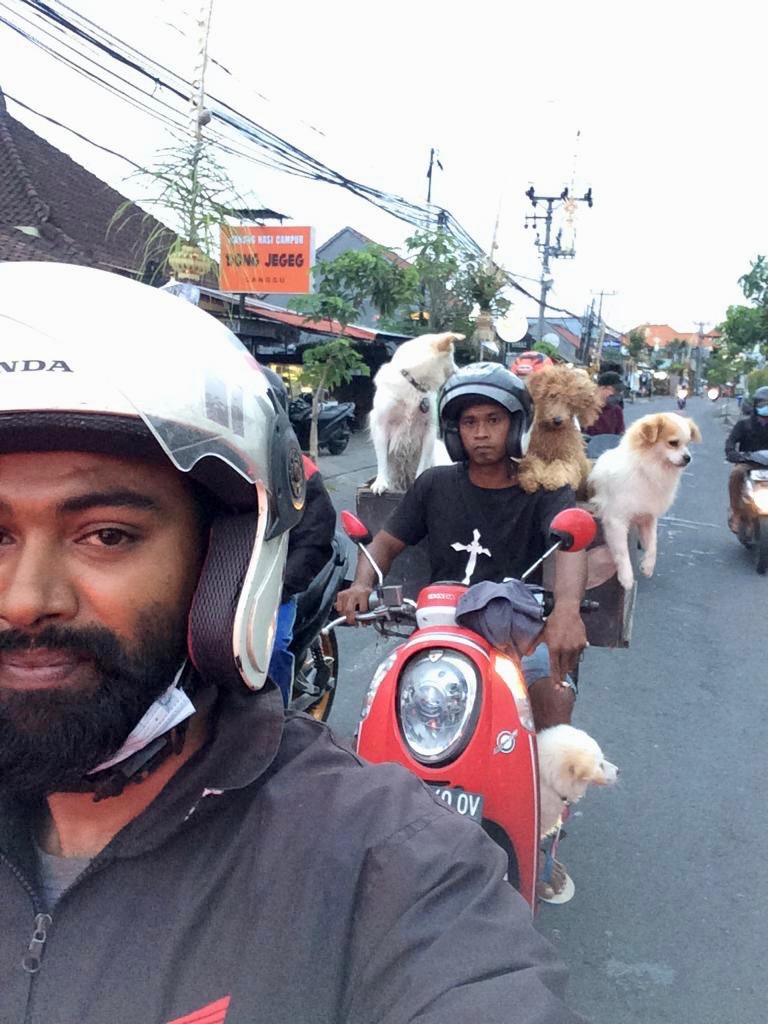
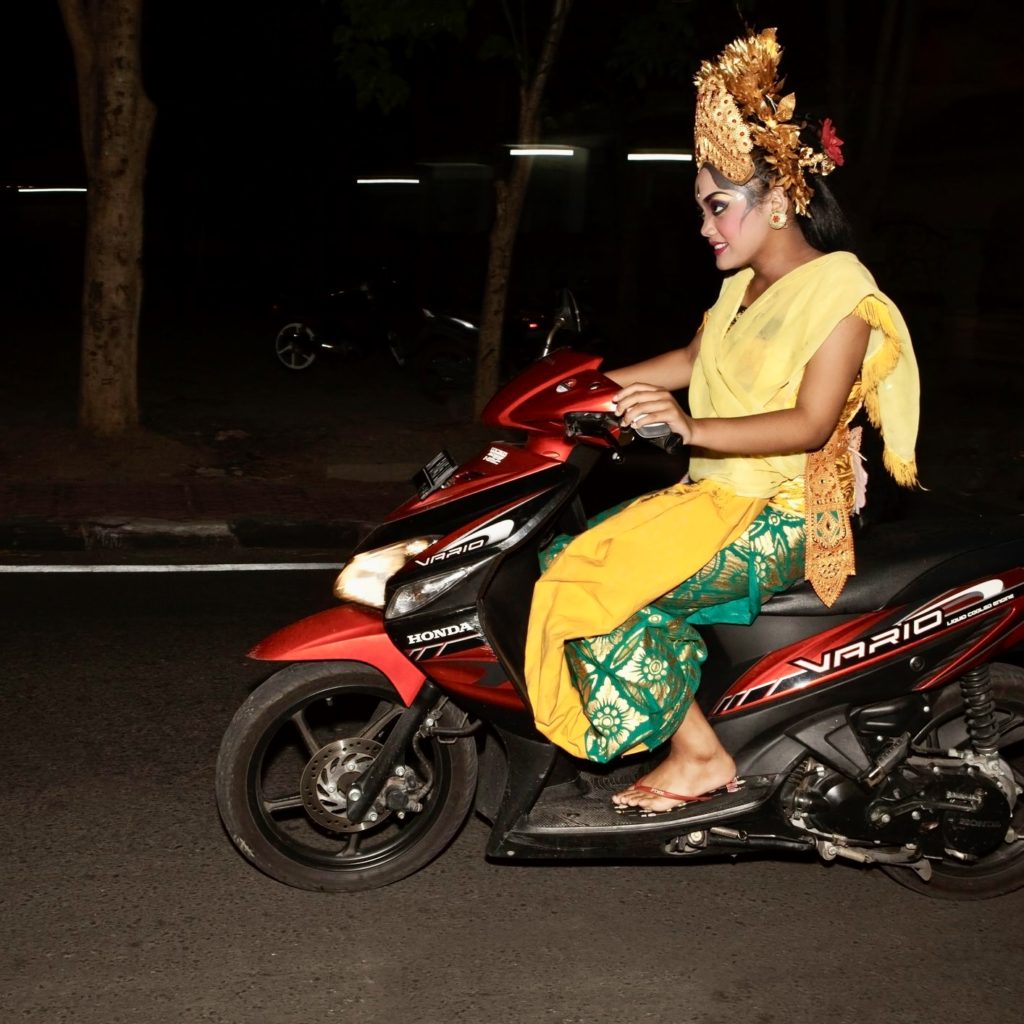
No, these two motorbikes did not crash.
Post Script on the Evil Ways of Macaling — The hold of Macaling on the popular imagination should not be underestimated. In 2002, there was a terrible bombing in the center of very tourist-popular town of Kuta. This town was the decadent H.Q. of bule drunkeness, nightclubing and whoring around. Two hundred and two people were killed in the bombing, including eighty eight Australians. The bombing was the act of Islamic terrorists to send a message against such immoral, sacriligious acts by the heathens. Many locals, however, think this tragedy was the work of Macaling. The demon entered the minds of local youths. Macaling so corrupted the minds of these young men that his malevolence gave rise to their murderous intent and actions.
BONUS
Please do not feel sorry for me as I was all alone, silent and meditating, on Nyepi. I mean, I was very introspective, when I was not busy chatting up my part-time girlfriend, who spent Nyepi with me. We spent the Day of Silence in my villa.
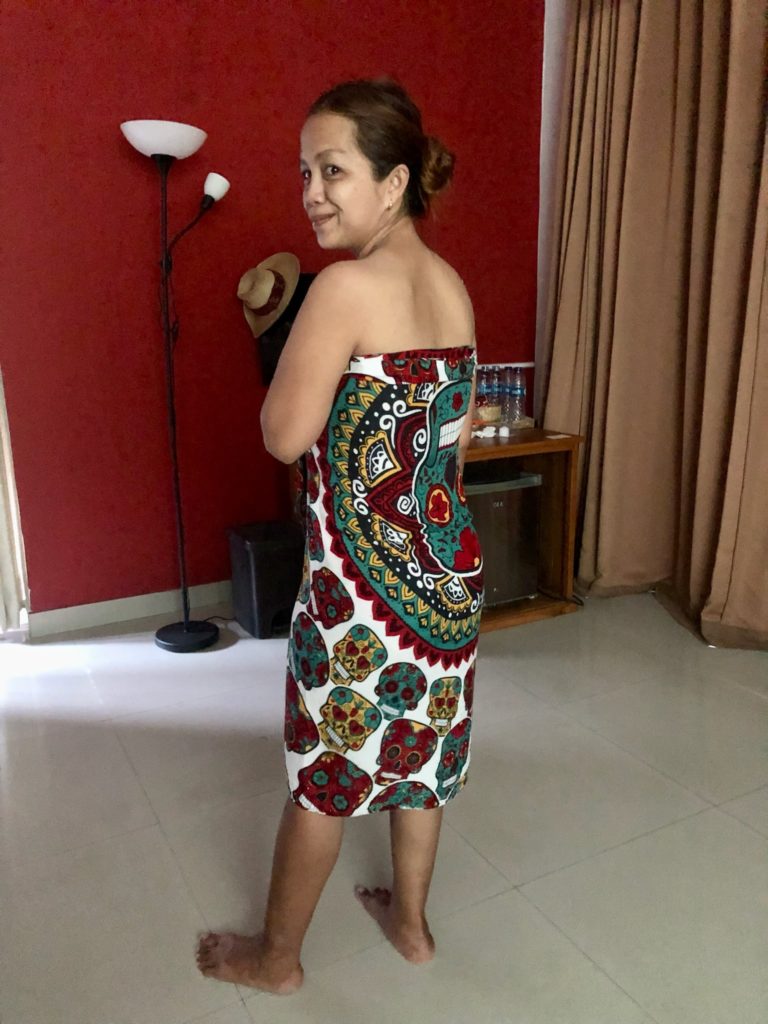
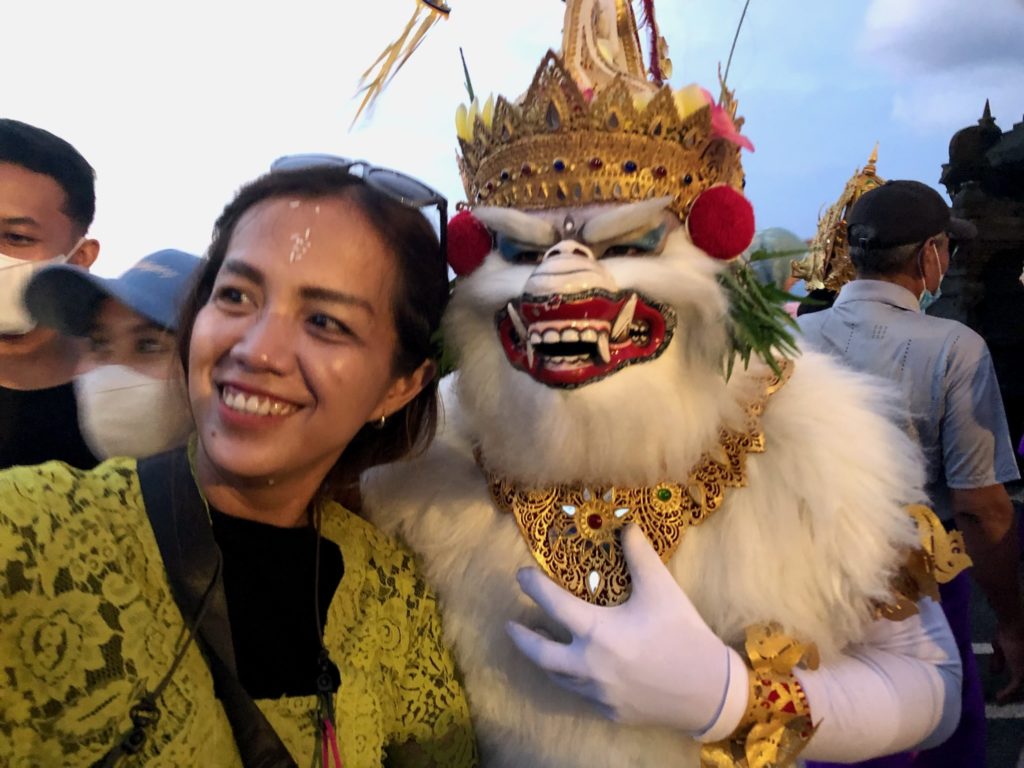
Left: Imelda modeling the latest in Day of the Dead sarongs (traditional wrap-around, long skirts worn by both men and women)
Please sign up below and subscribe to this website, a travelogue and literary journal. You will receive email notices of all new articles posted, about three a month. Email or other information will never be sold or used in any other way.
